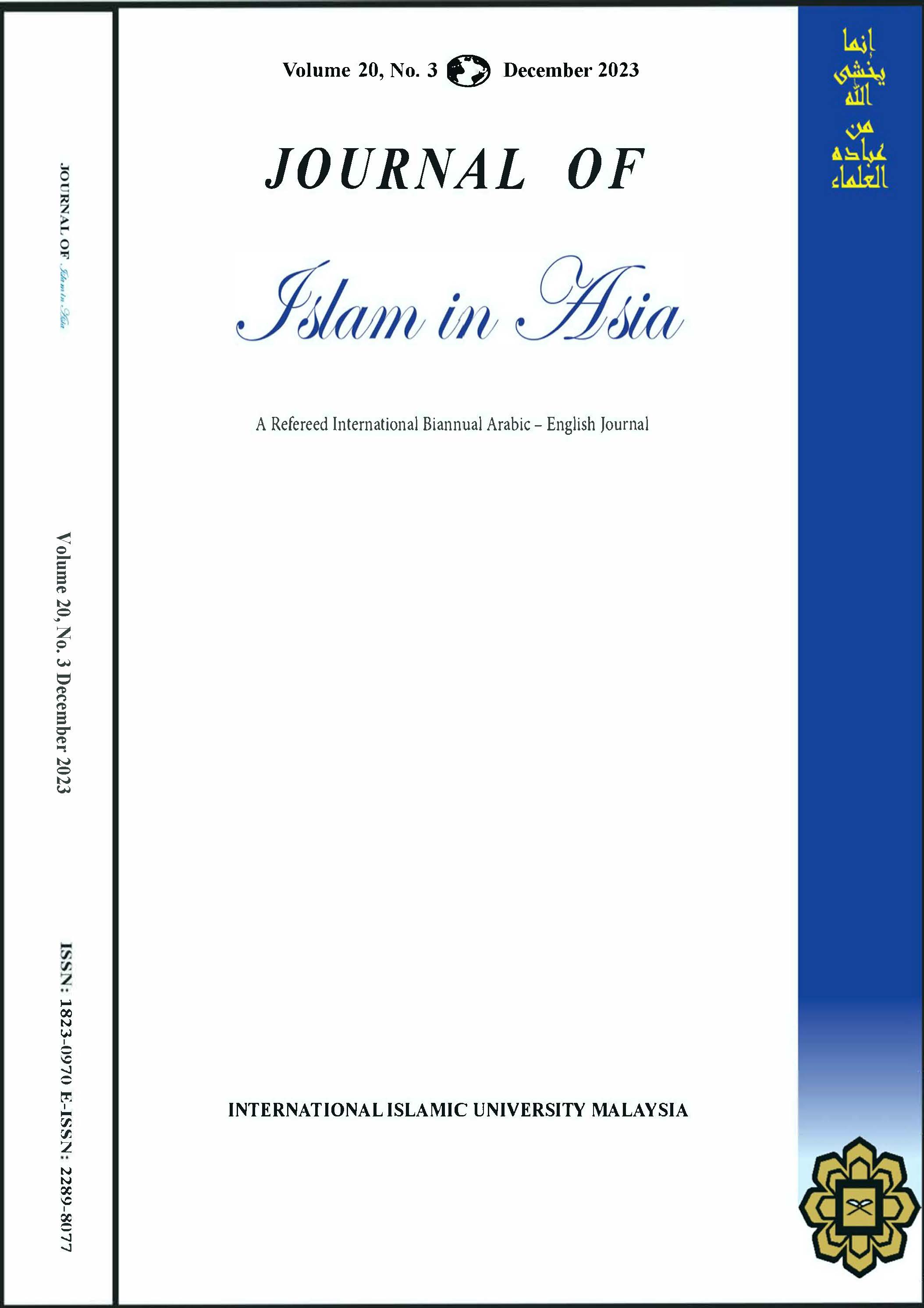نبذة عن تاريخ ترجمة معاني القرآن الكريم عموما
DOI:
https://doi.org/10.31436/jia.v20i3.1182Keywords:
التفسير, القرآن الكريم, الترجمات, المعاني, الدراسة, قارة أوربا, الآلبان, اللغات الأوربية, اللغات الأجنبيةAbstract
تشرح هذه الدراسة معنى الترجمة لغة واصطلاحا، ثمّ معنى التفسير لغة واصطلاحا. وتتحدث عن تفسير القرآن الكريم في عصر النبيّ صلى الله عليه وسلم، وكيف كان اهتمام النّبي صلى الله عليه وسلم بشرح الآيات الكريمة لأصحابه، واهتمام الصّحابة والتّابعين ومن تبعهم، ومن اشتهر من الصّحابة والتابعين وتابعي التابعين في هذا المجال. كما تهتم هذه الدراسة على اظهار الترجمات الأولى لمعاني القرآن الكريم في تاريخ قارة أوربا وخاصة لدى الآلبان، لأنّه قليل ما كُتب عنه مع التعرض لمعرفة السبب. ولعل هذه الدراسة تأتي بمعلومات جديدة في هذا الباب. وتوصلنا إلى أنّ مجال التفسير وفهم معاني القرآن الكريم قديم منذ عصر النبي صلى الله عليه وسلم. كما بينّا أنّ معاني القرآن الكريم إلى اللغات الأوربية تُرجمت من قبل غير المسلمين كذلك. وأخيرا، وتوصي هذه الدراسة بزيادة الاهتمام والكتابة عن ترجمة معاني القرآن الكريم إلى اللغات الأجنبية، وكذلك عن ترجمة معاني القرآن الكريم إلى اللغات التي لم تترجم معاني القرآن الكريم بعد
This study explains the meaning of translation linguistically and idiomatically, then the meaning of tafsir linguistically and idiomatically. It continues with the interpretation of the Noble Qur’an in the era of the Prophet (Peace and blessings be upon him), and the interest of the Prophet (Peace and blessings be upon him) to explain the noble verses to his companions, and the interest of the companions, followers and those who followed, and the famous companions, followers and followers of followers in this field. This study is also concerned with showing the first translations of the meanings of the Noble Qur’an in the history of the continent of Europe, especially among Albanians, because little was written and we know about it. This study will help with new information. And we concluded that the field of interpretation and understanding the meanings of the Noble Qur’an is old since the time of the Prophet (Peace and blessings be upon him). We also realized that the meanings of the Noble Qur’an were translated into European languages by non-Muslims as well. Finally, this study recommends increasing attention and writing about understanding the meanings of the Noble Qur’an into foreign languages, as well as into languages that have not yet translated the meanings of the Noble Qur’an.
References
المصادر والمراجع باللغة العربية:
Ibn Abd al-Halím ibn Abd as-Salãm ibn Abd Allah ibn al-Khidr ibn Muhamad ibn al-Khidr ibn Ibrahím ibn Ali ibn AbduAllãh. (1980). Muqaddimah fí Usûl at-Tafsír. Beirut: Dãr Maktabatil Hayãt.
Ibn Khaldûn. Al-Muqadimah. al-Qāhirah: Dār ash–Shuûb.
Muhamad ibn Salih, Ibn Uthaymin. Sharh Usool fi at-Tafsir. (2004). al-Qāhirah: Maktabatu Sunnah.
Bizyan, Sadí. Al-Islãm fí Aurûbã Al-Garbiyah. (1992). Al-Jazãir: dar Al-Hiqmah.
Rajab Jasyar, Buya. (2004). Al-Albaniyun, Al-Arnaut, wal Islam. 1st Edition. al-Qāhirah: dãr As-Salãm.
Rajab Jasyãr, Bûyã. (2004). Al-Muslimûn fí Yuguslãfia. 1st Edition. al-Qāhirah: dãr As-Salãm.
Al-Bunyãn, Ahmad ibn Abdullãh ibn Muhamad. Tarjamat maãní al-qurãn al-Qarím ilã al-lugah al-Ingliziyah we muraãt khurûj al-kalãm an muqtada az-zãher dirãsah tatbiqiyah alã baãd ayãt az-zikr al-haqím.
Jamaãh min al-Mushriqín, (1933). Dãiretul maãrif al-Islãmiyah. Bayrût: Matba’ah abdul hafíz al-baśãt.
Jílû, Hasen bin Ramadhãn. Tãríkh tatavvuri tarjamah maãní al-Qurãn al-Qarím fi Mantiqah al-Balqãn.
Hiqmat, ibn Basyír ibn Yasín. (2011). Dawãbit Tarjamah Maãni al-Qurãn al Qarím. Al-Madína Al-Munawarah.
Al-Khatíb. Abdullãh Abdurrahmãn. Al-Juhûd al Mabdhûlah fi Tarjamah Maãni al-Qurãn al-Qarím ilã al-Lugah al-Ingliziyah.
Az-Zahabi, Muhamad as-Sayid Husain. (2010). At-Tafsír wal Mufasirûn. al-Qãhirah: Maktabah Wahbah.
Zarzûr, Adnãn Muhamad. (1995). Madkhal ilã Tafsír al-Qurãn al-Qarím wa Ulûmih. Dimeshq: Dãr Al-Qlem.
Az-Zarqãní, Muhamad Abdul Azím. (1996). Manãhil al-Urfãn fí Ulûmil Qurãn. Bayrût: Dãrul Qutub al-Ilmiyah.
Al-Asqalãní, Ahmad ibn Ali ibn Hajar Abû al-Fadl Ash-Shãfií. (2010). Fat’hul Bãrí Sharh Sahih al-Bukhãrí. Bayrût: Dãrul Marifah.
Krasníshí, Shawkat ibn Muharam. Nabdhah an Tarjamati Maãní al-Qurãn al-Qarím ilã al-Lugah al-Albãniyah.
An-Namir, Abdul Munim. Ilmu at-Tafsír. Al-Qãhirah: Dãr al-Kitãb al-Misri.
المصادر والمراجع باللغة الألبانية:
Bãrdhi, Ismaíl. Hafíz Ibrahím Dallíu dhe Ekzegjezã e tij Kur’ãnore. Scopie.
Behrãmi, Emin. (1997). Qãsje studimõre rreth katër përkthímeve të Kur’ãnit në gjuhën shqípe. Pristínë.
Dallíu, Hafíz Ibrãhím. (2005). Ajka e Kuptímeve të Kur’ãni Kerímit. Tirãnë: Lilo.
Ibrãhími, Nexhat. (2000). Islãmi në trojet Iliro-Shqiptãre gjatë Shekujve. Pristínë.
Zekãj, Ramíz. (1997). Zhvillimi i Kultûrës Islame te Shqiptãrët gjatë Shekullit XX. Tirãnë: Institûti shqiptãr i mendimit dhe qytetërímit islamik.
المواقع الإلكترونية:
Anãní. (2021). Muqaddimah alã Daw’ ‘Dirasãt At-Tarjamah’: Al-Mabhath Al-Bejnij Al-Jadíd an Tarjamah An-Nusûs Al-Muqaddisah. http://www.alfãisalmag.com/?p=16444
Krasníshí, Shawkat ibn Muharam. Nabdhah an Tarjamati Maãní al-Qurãn al-Qarím ilã al-Lugah al-Albãniyah. http://www.muslim-library.com/dl/books/ar4404.pdf
Jawdah. (2021). Aqdam 8 Tarjamãt Lil Qur’ãn Al Qarím Bilugãt Mukhtalifah Hawla Al-Ãlam.




